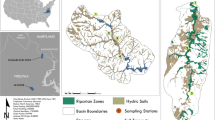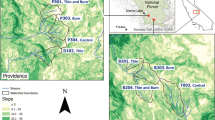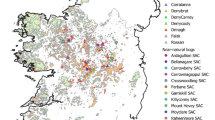Abstract
We reviewed literature data on pocosins and associated wetlands of the Carolina coastal plain to 1) characterize the surface and subsurface water quality of undisturbed pocosins, 2) identify the processes controlling solution C, N, and P concentrations, and 3) examine the effects of disturbance on water quality and nutrient export. We hypothesized that the key to predicting nutrient losses from disturbed pocosins lies in understanding how disturbance affects both hydrologic export and the processes controlling solution C, N, and P concentrations. Since the development of pocosins for commercial forestry and agriculture involves a complex series of disturbances (drainage, vegetation removal, fire, and fertilization), we analyzed the specific effects of these component disturbances as well as the composite effects of agricultural and silvicultural development.
Surface and subsurface waters of undisturbed pocosins are dominated by H+ cations (100–1000 μeq/L) and SO 2−4 anions (475 μeq/L), with Ca2+ concentrations below 50 μeq/L, and are chemically similar to more northem ombrotrophic bogs. However, pocosin waters are more acid and contain higher concentrations of Na+, SO 2−4 , and Cl−, probably due to their coastal environment. Solution export of N from undisturbed pocosins is primarily as organic N (74–88%), but even though organic P comprises 73–93% of total dissolved P in subsurface pore waters, 57–87% of P exported is inorganic PO 3−4 . C:P ratios increase during the growing season in subsurface waters from 2355∶1 in June to 9563∶1 in August, as soluble organic P and PO 3−4 supply toin situ anion-exchange resins decline.
Biological processes control C, N, and P transformations in pocosin soils and are strongly influenced by hydrology and P availability. Seasonal changes in water table depth suggest seasonal fluctuations in soil redox potential that could affect a variety of processes controlling water quality and nutrient export and may cause changes in the source of pocosin drainage waters (surface, subsurface, or mineral soil), thus affecting water quality. Phosphorus availability limits plant growth and may play an important role in controlling nutrient export due to its potential influence on rates of C, N, and P cycling.
Drainage of otherwise undisturbed pocosins does not affect total runoff volume but may affect nutrient export due to changes in the source of drainage waters. Drainage coupled with vegetation removal increases total runoff, increasing freshwater inputs downstream. Fire increases soil nutrient availability and may increase nutrient export when coupled with vegetation removal. Fertilization effects on nutrient export will be determined by fertilization frequency and by the degree of saturation of the immobilization capacity of soil microorganisms, the uptake capacity of plant roots, and the sorption capacity of soil minerals. Agricultural development increases C, N, and P concentrations in drainage waters and N and P export. Silviculture may have less severe effects on nutrient export, since harvesting and fertilization occur less frequently, but may reduce runoff, reducing freshwater inputs downstream.
Similar content being viewed by others
Literature Cited
Ash, A.N., C.B. McDonald, E.S. Kane, and C.A. Pories. 1983. Natural and modified pocosins: literature synthesis and management options. U.S. Fish and Wildlife Service, Division of Biological Services, Washington, DC, USA. FWS/OBS 83/04.
Barber, R.T., W.W. Kirby-Smith, and P.E. Parsley. 1979. Wetland alterations for agriculture. p. 642–651.In D.E. Greeson, J.R. Clark, and J.E. Clark (eds.) Wetland Functions and Values: The State of Our Understanding. American Water Resources Association, Minneapolis, MN, USA.
Barnes, J.S. 1981. Agricultural adaptability of wet soils of the North Carolina coastal plain. p. 225–237.In C.J. Richardson (ed.) Pocosin Wetlands. Hutchinson Ross Publishing Company, Stroudsburg, PA, USA.
Blancher, P.J., and D.K. McNicol. 1987. Peatland water chemistry in central Ontario in relation to acid deposition. Water, Air, and Soil Pollution 35: 217–232.
Brinson, M.M. 1991. Landscape properties of pocosins and associated wetlands. Wetlands 11: 441–465.
Campbell, R.G. and J.H. Hughes. 1991. Impact of forestry operations on pocosins and associated wetlands. Wetlands 11: 467–479.
Campbell, R.G. and J.H. Hughes. 1981. Forest management systems in North Carolina pocosins: Weyerhaeuser. p. 199–213.In C.J. Richardson (ed.) Pocosin Wetlands. Hutchinson Ross Publishing Company, Stroudsburg, PA, USA.
Christensen, N.L., R.B. Burchell, A. Liggett, and E.L. Simms. 1981. The structure and development of pocosin vegetation. p. 43–61.In C.J. Richardson (ed.) Pocosin Wetlands. Hutchinson Ross Publishing Company, Stroudsburg, PA, USA.
Christensen, N.L., R.B. Wilbur, and J.S. McLean. 1988. Soil-vegetation correlations in the pocosins of Croatan National Forest, North Carolina. U.S. Fish and Wildlife Service Biological Report 88(28).
Daniel, C., III. 1981. Hydrology, geology and soils of pocosins: a comparison of natural and altered systems. p. 69–108.In C.J. Richardson (ed.) Pocosin Wetlands. Hutchinson Ross Publishing Company, Stroudsburg, PA, USA.
Fox, R.L. and E.J. Kamprath. 1971. Adsorption and leaching of P in acid organic soils and high organic matter sand. Soil Science Society America Proceedings 35: 154–156.
Gambrell, R.P., J.W. Gilliam, and S.B. Weed. 1975. Denitrification in subsoils of the North Carolina coastal plain as affected by soil drainage. Journal of Environmental Quality 4: 311–316.
Gambrell, R.P. and W.H. Patrick, Jr. 1978. Chemical and microbiological properties of anaerobic soils and sediments. p. 375–423.In D.D. Hook and R.M.M. Crawford (eds.) Plant Life in Anaerobic Environments. Ann Arbor Scientific Publishers Inc., Ann Arbor, MI, USA.
Gilliam, J.W. and R.W. Skaggs. 1981. Drainage and agricultural development: effects on drainage waters. p. 109–124.In C.J. Richardson (ed.) Pocosin Wetlands. Hutchinson Ross Publishing Company, Stroudsburg, PA, USA.
Gilliam, J.W., R.W. Skaggs, and S.B. Weed. 1978. An evaluation of the potential for using drainage control to reduce nitrate loss from agricultural fields to surface waters. Water Resources Research Institute of the University of North Carolina, Raleigh, NC, USA. UNC-WRRI-78-128.
Glaser, P.H., G.A. Wheeler, E. Gorham, and H.E. Wright, Jr. 1981. The patterned mires of the Red Lake Peatland, northem Minnesota: vegetation, water chemistry and landforms. Journal of Ecology 69: 575–599.
Gregory, J.D., R.W. Skaggs, R.G. Broadhead, R.H. Culbreth, J.R. Bailey, and T. Foutz. 1984. Hydrologic and water quality impacts of peat mining in North Carolina. Water Resources Research Institute of the University of North Carolina, Raleigh, NC, USA. UNC-WRRI-84-214.
Harriss, R.C., D.I. Sebacher, and F.P. Day. 1982. Methane flux in the Great Dismal Swamp. Nature 297: 673–674.
Heath, R.C. 1975. Hydrology of the Albemarle-Pamlico region of North Carolina: a preliminary report on the impact of agricultural developments. U.S. Geological Survey Water Resources Investigation, U.S. Geological Survey, Raleigh, NC, USA. #9–75
Kilmer, V.J., J.W. Gilliam, R.T. Joyce, and J.F. Lutz. 1972. Loss of fertilizer nutrients from soils to drainage waters. Water Resources Research Institute of the University of North Carolina, Raleigh, NC, USA. UNC-WRRI-72-55.
Kirby-Smith, W.W. and R.T. Barber. 1979. The water quality ramifications in estuaries of converting forest to intensive agriculture. Water Resources Research Institute of the University of North Carolina, Raleigh, NC, USA. UNC-WRRI-79-148.
Larsen, S. 1967. Soil phosphorus. Advances in Agronomy 19: 151–210.
MacCarthy, R. and C.B. Davey. 1976. Nutritional problems of Pinus taeda L. (Loblolly Pine) growing on pocosin soil. Soil Science Society America Journal 40: 582–585.
Maki, T.E. 1974. Factors affecting forest production on organic soils. p. 119–135.In: A.R. Aandahl, S.W. Buol, D.E. Hill, and H.H. Bailey (eds.) Histosols: Their Characteristics, Classification, and Use. Soil Science Society America, Madison, WI, USA.
McGill, W.B. and C.V. Cole. 1981. Comparative aspects of cycling of organic C, N, S and P through soil organic matter. Geodenna 26: 287–309.
Moore, P.D. and D.J. Bellamy. 1974. Peatlands. Springer-Verlag, New York, NY, USA.
Noltemeier, D.D. 1984. Comparison of water quality in coastal plain streams of North Carolina. M.S. Thesis, East Carolina University, Greenville, NC, USA.
Otte, L.J. 1981. Origin, development, and maintenance of the pocosin wetlands of North Carolina. Report to North Carolina Natural Heritage Program. Raleigh, NC, USA.
Otte, L.J. and L.K. Loftin. 1983. Water chemistry of the pocosins of the Croatan National Forest, North Carolina. Unpublished report to the Water Resources Research Institute of the University of North Carolina, Raleigh, NC, USA. WRRI 84-02-62002.
Radford, A.E., H.E. Ahles, and C.R. Bell. 1968. Manual of the Vascular Flora of the Carolinas. University of North Carolina Press, Chapel Hill, NC, USA.
Richardson, C.J. 1983. Pocosins: vanishing wastelands or valuable wetlands? BioScience 33: 626–633.
Richardson, C.J. 1985. Mechanisms controlling phosphorus retention capacity in freshwater wetlands. Science 228: 1424–1427.
Richardson, C.J., R. Evans, and D. Carr. 1981. Pocosins: an ecosystem in transition. p. 3–19.In C.J. Richardson (ed.) Pocosin Wetlands. Hutchinson Ross Publishing Company, Stroudsburg, PA, USA.
Richardson, C.J. and J.W. Gibbons. 1991. Pocosins, Carolina bays, and mountain bogs.In B. Martin,et al. (eds.) Biotic Communities of the Southeast. Wiley, New York, NY, USA (in press).
Richardson, C.J. and P.E. Marshall. 1986. Processes controlling movement, storage and export of phosphorus in a fen peatland. Ecological Monographs 56: 279–302.
Richardson, C.J., M.R. Walbridge, and A. Burns. 1988. Soil chemistry and phosphorus retention capacity of North Carolina coastal plain swamps receiving sewage effluent. Water Resources Research Institute of the University of North Carolina, Raleigh, NC, USA. UNC-WRRI-88-241.
Riekirk, H. and L.V. Korhnak. 1985. Environmental effects of silviculture in pine flatwoods. p. 528–535.In E. Shoulders (ed.) Proceedings of the third biennial southern silvicultural research conference. U.S.D.A. Forest Service, Southern Forest Experiment Station, New Orleans, LA, USA. General Technical Report SO-54.
Schwintzer, C.R., and T.J. Tomberlin. 1982. Chemical and physical characteristics of shallow ground waters in northem Michigan bogs, swamps, and fens. American Journal of Botany 69(8): 1231–1239.
Simms, E.L. 1985. Growth response to clipping and nutrient addition in Lyonia lucida and Zenobia pulverulenta. American Midland Naturalist 114: 44–50.
Simms, E.L. 1987. The effect of nitrogen and phosphorus addition on the growth, reproduction, and nutrient dynamics of two ericaceous shrubs. Oecologia 71: 541–547.
Skaggs, R.W. 1978. A water management model for shallow water table soils. Water Resources Research Institute of the University of North Carolina, Raleigh, NC, USA. UNC-WRRI-78-134.
Skaggs, R.W., J.W. Gilliam, T.J. Sheets, and J.S. Bames. 1980. Effect of agricultural land development on drainage waters in the North Carolina tidewater region. Water Resources Research Institute of the University of North Carolina, Raleigh, NC, USA. UNC-WRRI-80-159.
Snyder, J.R. 1980. Analysis of coastal plain vegetation Croatan National Forest, North Carolina. Veroffentlichungen des Geobotanischen Institutes der Eidige Technische Hochschule Stiffung Rubel 69: 40–112.
Walbridge, M.R. 1982. Vegetation patterning and community distribution in four high-elevation headwater wetlands in West Virginia. M.S. Thesis, West Virginia University. Morgantown.
Walbridge, M.R. 1989. Increased P availability to in situ anion-exchange resins following fire in a North Carolina coastal plain pocosin. Poster presented at Tenth Annual Meeting, Society of Wetland Scientists, May 30–June 2, 1989, Orlando, FL, USA.
Walbridge, M.R. 1991. Phosphorus availability in acid organic soils of the lower North Carolina coastal plain. Ecology 72: 2083–2100.
Walbridge, M.R., C.J. Richardson, and W.T. Swank. 1991. Vertical distribution of biological and geochemical phosphorus subcycles in two southern Appalachian forest soils. Biogeochemistry 13: 61–85.
Wendel, G.W., T.G. Storey, and G.M. Byram. 1962. Forest fuels on organic and associated soils in the coastal plain of North Carolina. U.S.D.A. Forest Service, Southeastem Experiment Station, Asheville, NC, USA. Paper No. 144.
Wilbur, R.B. 1985. The effects of fire on nitrogen and phosphorus availability in a North Carolina coastal plain pocosin. Ph.D. Dissertation, Duke University, Durham, NC, USA.
Wilbur, R.B. and N.L. Christensen. 1983. Effect of fire on nutrient availability in a North Carolina coastal plain pocosin. American Midland Naturalist 110: 54–61.
Williams, T.M. and G.R. Askew. 1988. Impact of drainage and site conversion of pocosin lands on water quality. p. 213–218.In D.D. Hook, W.H. McKee, Jr., H.K. Smith, J. Gregory, V.G. Burrell, Jr., M.R. DeVoe, R.E. Sojka, S. Gilbert, R. Banks, L.H. Stolzy, C. Brooks, T.D. Matthews, and T.H. Shear (eds.) The Ecology and Management of Wetlands, Volume 2: Management, Use and Value of Wetlands. Timber Press, Portland, OR, USA.
Williams, T.M. and D.J. Lipscomb. 1981. Water table rise after cutting on coastal plain soils. Southern Journal of Applied Forestry 5: 46–48.
Wood, T.E., F.H. Bormann, and G.K. Voigt. 1984. Phosphorus cycling in a northern hardwood forest: biological and chemical control. Science 223: 391–393.
Woodwell, G.M. 1958. Factors controlling growth of pond pine seedlings in organic soils of the Carolinas. Ecological Monographs 28: 219–236.
Author information
Authors and Affiliations
Rights and permissions
About this article
Cite this article
Walbridge, M.R., Richardson, C.J. Water quality of pocosins and associated wetlands of the Carolina Coastal Plain. Wetlands 11 (Suppl 1), 417–439 (1991). https://doi.org/10.1007/BF03160760
Received:
Revised:
Issue Date:
DOI: https://doi.org/10.1007/BF03160760




